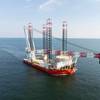(Photo: Courtesy Northrop Grumman Newport News)
The Executive Control Board of the National Shipbuilding Research Program Advanced Shipbuilding Enterprise (NSRP ASE) selected seven new research projects as part of the Navy/Industry co-funded portfolio. The seven new projects, valued at approximately $20 million including industry cost share, were in response to the latest NSRP ASE solicitation released in February and continue the successful implementation of the Program’s Strategic Investment Plan. A brief description of each project with a list of participants follows:
Common Parts Catalog (CPC) Implementation: This project will provide full scale testing, refinement and implementation of a Common Parts Catalog for Electric Boat, Bath Iron Works and Northrop Grumman Ship Systems (and also enable future implementation at Northrop Grumman Newport News and National Steel and Shipbuilding Company) that will interface with existing cataloging “best practices,” support continuous process improvements, and provide both short and long term cost savings opportunities. These “best practices” are categorized as part data standards, part commonality/equivalency and part data configuration management. The resulting Common Parts Catalog will be applicable to all commercial and military segments of the U.S. shipbuilding and repair industry after successful implementation at the three project shipyards. The Executive Control Board, exploiting what was recognized as a significant opportunity for enhanced technology transfer industry sharing, and increased savings benefits, made provisions at selection to include additional shipyards not initially involved in the effort. The catalog will provide increased speed and accuracy in information retrieval, reductions in parts through standardization, and enable data reuse by providing more visibility and timely access to the data. A robust search capability will eliminate existing duplicate part numbers and eliminate the generation of new part numbers for components already shown in the Catalog. Fleet maintenance issues addressed include increased variety of parts to maintain the fleet and visibility of design or construction yard inventory. Electronic part sharing will virtually integrate Navy inventories with shipyards. Participants: General Dynamics Electric Boat, Bath Iron Works, Northrop Grumman Ship Systems, Northrop Grumman Newport News, and National Steel and Shipbuilding Company.
Development of ISE Interoperability Modules: This project builds on the interoperability infrastructure and industry-standardizations processes developed by the existing “Deployment of the Integrated Shipbuilding Environment” project, with the scope of work focused on the development of two new modules. The project will use product model data standards to develop interoperable exchanges between various CAD packages for HVAC requirements and develop the interface necessary to deploy a Common Parts Catalog across the shipbuilding industry. This improved interoperability will achieve cost reductions in Navy and commercial shipbuilding processes across shipyards and across the design/build/support life cycle. Participants: General Dynamics Electric Boat, Northrop Grumman Ship Systems, Northrop Grumman Newport News, Gulf Coast Region Maritime Technology Center, Intergraph Corp., Integration Partners, Inc., IBM, National Industrial Information Infrastructure Protocols (NIIIP), - Naval Surface Warfare Center — Carderock Division, SENER Ingenieria Y Sistemas, SIMSMART Inc., and STEP Tools Inc.
Managing the Extended Lean Enterprise: Application of World Class Business Processes to Shipyard Management: This project builds on the current Lean Enterprise project, which focuses on internal shipyard processes—both on and above-the-shop-floor for naval and commercial shipbuilding and repair. This new initiative expands the focus to the larger value stream, adding interaction with the customer and suppliers. Specifically, it adds Lean implementations in the important shipyard processes of: design/engineering; onboard outfitting and testing; specification materials purchasing; and four material streams (steel, pipe/valves/fittings, consumables, and services). Value stream mapping is used to determine as-is and to-be models for each of these processes. Members of the improved value chain will appear functionally as one large extended Lean Enterprise performing as a fluid organization that can be structurally modified to make radical changes to product speed, quality and cost. Participants: Atlantic Marine, Todd Pacific Shipyards, Bath Iron Works, Puget Sound Naval Shipyard, SUPSHIP Puget Sound, V2R Consulting, P. Jaquith and Associates, Malone Consulting, W&O Supply, Hagemeyer North America, Moran Environmental Recovery and O’Neal Steel Inc.
Developing Lean Enterprise Simulation Exercises for Shipbuilding and Repair: This project will develop five Lean training modules, each composed of a physical simulation exercise based on a shipbuilding or ship repair process. The modules include presentation materials including instructor and participant guides. These physical simulation tools will include actual applications from shipbuilding and repair and will incorporate the entire supply chain, as opposed to current exercises that focus solely on manufacturing operations. Included in the exercises will be processes representing both shop-floor and above-the-shop-floor activities, and will be designed to demonstrate the impact of Lean on a low-volume and high-variety environment. Participants: Old Dominion University, Northrop Grumman Newport News and South Tidewater Association of Ship Repairers.
Second Tier Shipyard Design Enhancement Program: This project will leverage the developmental work accomplished in the ISE, Harvest and Material Standards NSRP projects to expand the capabilities of the design software of choice for second tier shipyards (ShipConstructor) in the areas of Common Parts Catalog interface, HVAC, and Piping. Participants: Bender Shipbuilding & Repair, Albacore Research, Bollinger Shipyards, General Dynamics Electric Boat, Marinette Marine, Northrop Grumman Ship Systems, Todd Pacific Shipyard, VT Halter Marine, Alan C. McClure & Associates, Elliot Bay Design Group, Genoa Design, Murray and Associates Ltd., Proteus Engineering, Atlantec Enterprise Solutions, Knowledge Based Systems, Vexcel, Bishop State Community College and University of Southern Mississippi.
SPARS Deploy: This project builds on the business process and infrastructure re-engineering processes developed by the previous Shipbuilding Partners and Suppliers (SPARS) project. The SPARS objective is to create a shipbuilding Virtual Enterprise using internet technology to enhance business interaction between the shipbuilders and their suppliers resulting in significant reductions in cycle time, labor content and material acquisition and management costs. The SPARS team will develop two additional electronic business processes to re-engineer current manual Shipyard-Supplier interactions that are labor intensive, paper-based, error prone and have long cycle times. The new functionality Includes Ship Repair and Engineering Center (SHIPREC) to support rapid material sourcing and buying as is frequently required in ship repair; and, Vendor Expediting which will extract supplier delivery information from Shipyard ERP systems and web-enable the ability for shipyards to post delivery expectations for suppliers on line and for suppliers to confirm delivery dates and/or identify potential issues. Participants: General Dynamics Electric Boat, Northrop Grumman Newport News, Northrop Grumman Ship Systems, Bath Iron Works, Todd Pacific Shipyards, Portsmouth Naval Shipyard, NIIIP and IBM.
Wireless Equipment Monitoring and Control System (WEMACS): The WEMACS Project exploits an ongoing baseline wireless system installation project at Portsmouth Naval Shipyard to further research and develop a comprehensive solution for the extensive monitoring, control and utilization analysis of shipyard material handling equipment (forklifts, straddle trucks, cranes, and similar vehicles). The resultant system would monitor equipment location, electronically restrict access to qualified operators, analyze equipment usage, enable wireless transmission of work orders, and monitor certain vital functions. Benefits include reduction of maintenance costs and improved reliability and availability of the MHE by establishing the ability to locate equipment continuously, enhance safety and security by preventing use by unauthorized and unqualified operators, document time and location of major impact incidents, and remotely monitor machinery health functions. Participants: I.D. Systems, Inc., NASSCO, Northrop Grumman Ship Systems, Portsmouth Naval Shipyard, RLW, Inc. and the Applied Research Laboratory at Penn State University.
Sponsored Content
Maritime leaders unite to tackle ocean plastic with launch of new alliance: the Maritime Association for Clean Seas

ABS Wavesight Advantage™: One Intelligent, Connected Maritime Platform to Transform Complexity into Operational Clarity

Subscribe for
Maritime Reporter E-News
Maritime Reporter E-News is the maritime industry's largest circulation and most authoritative ENews Service, delivered to your Email five times per week










